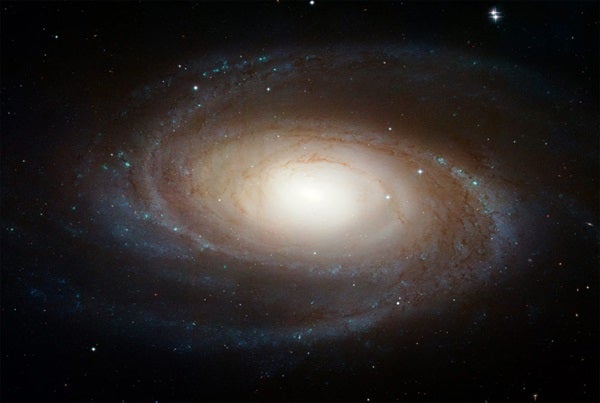On Monday morning, at the American Astronomical Society meeting in Honolulu, astronomers released a new Hubble Space Telescope image of the galaxy M81 in Ursa Major. The image is by far the best-ever produced of this favorite galaxy among observers the world over, sometimes called “Bode’s Galaxy” for Johann Bode, the German astronomer who discovered it in 1774. M81 is a bright Sb-type spiral, one of the brightest galaxies in the northern sky and, at a distance of 11.6 million light-years, one of the closest prominent spirals outside the Local Group of galaxies.
The image was made by a team of astronomers and presented at the meeting by Andreas Zezas of the Harvard-Smithsonian Center for Astrophysics in Cambridge, Massachusetts. “The amazing detail in this image took our breath away,” says Zezas. “We can see individual stars like tiny grains of sand.” Zezas says the image, at high magnification, shows many background galaxies through the arms of M81 and around it in great detail for the first time.
The image is a composite of 90 pictures taken with Hubble’s Advanced Camera for Surveys between 2004 and 2006. Zezas described the many stunning features in the image clearly shown in unprecedented detail, including the galaxy’s HII regions, O and B associations of stars, open star clusters, globular star clusters, and even individual stars within the galaxy’s arms. The picture contains about 2.5 days of total exposure time.
M81’s spiral arms, which wind all the way down into the nucleus, contain young, hot, blue stars that turned on in the last few million years. The image shows another population of stars that formed about 600 million years ago. Regions in the image that appear slightly greenish represent bright areas of star formation. Dust lanes are also visible winding their way along the galaxy’s spiral arms. “The presence of dust lanes shows that star formation is happening all the way down into the nucleus,” says Zezas.
Zezas has several goals with his M81 research, he says. First, he aims to map star-forming activity within the galaxy. Second, he wants to understand where and when star clusters formed. Third, he wants to map and study black holes and neutron stars within the galaxy. M81 appears to be undergoing a surge of star formation due to a close encounter it underwent with nearby spiral galaxy NGC 3077 and the nearby dusty, explosive galaxy M82 some 300 million years ago. Astronomers will study the new image to map the star-formation history of M81 and to correlate observations of black holes and neutron stars made with the Chandra X-ray Observatory.










